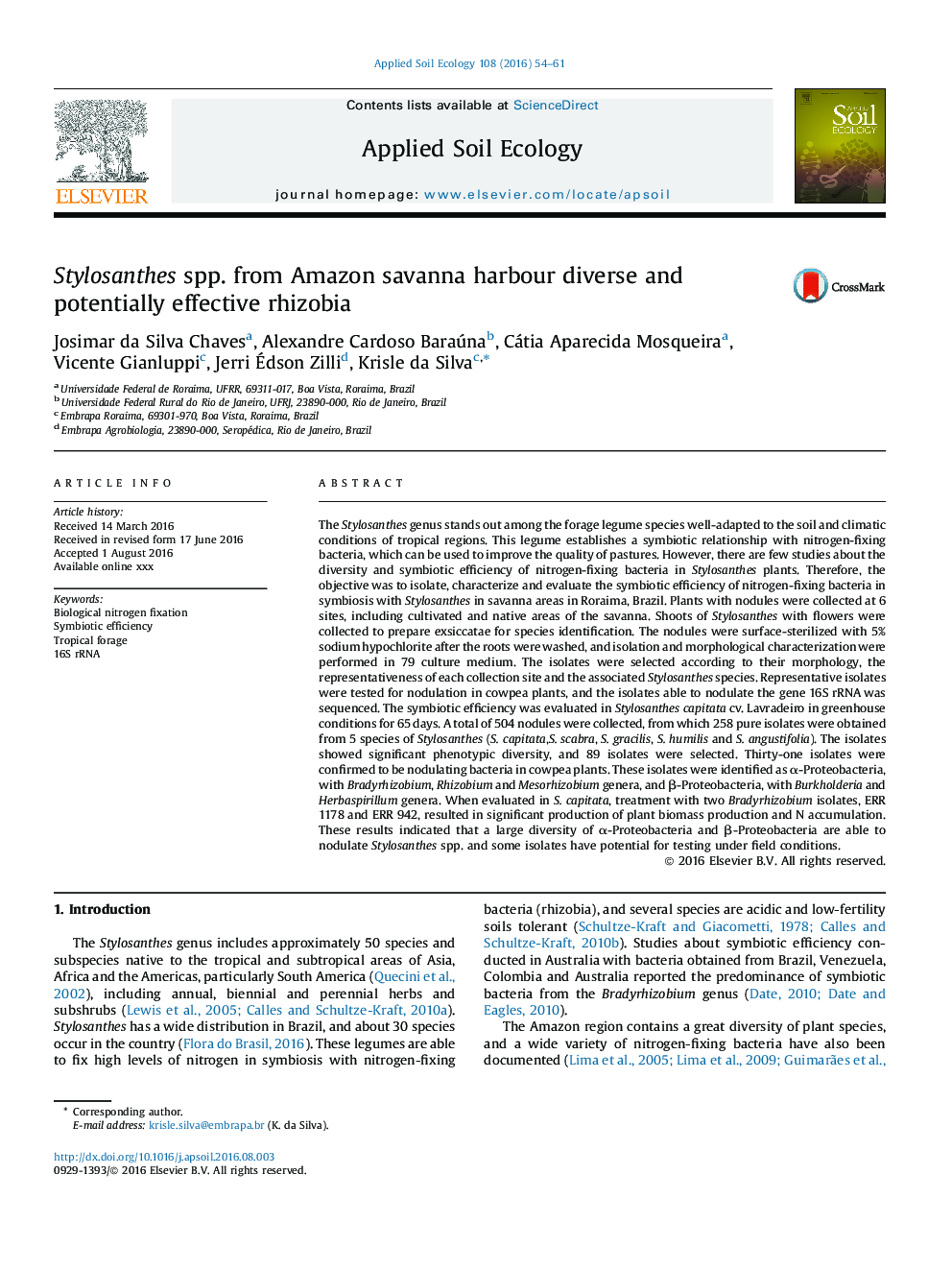| کد مقاله | کد نشریه | سال انتشار | مقاله انگلیسی | نسخه تمام متن |
|---|---|---|---|---|
| 6297431 | 1617775 | 2016 | 8 صفحه PDF | دانلود رایگان |
عنوان انگلیسی مقاله ISI
Stylosanthes spp. from Amazon savanna harbour diverse and potentially effective rhizobia
دانلود مقاله + سفارش ترجمه
دانلود مقاله ISI انگلیسی
رایگان برای ایرانیان
کلمات کلیدی
موضوعات مرتبط
علوم زیستی و بیوفناوری
علوم کشاورزی و بیولوژیک
بوم شناسی، تکامل، رفتار و سامانه شناسی
پیش نمایش صفحه اول مقاله

چکیده انگلیسی
The Stylosanthes genus stands out among the forage legume species well-adapted to the soil and climatic conditions of tropical regions. This legume establishes a symbiotic relationship with nitrogen-fixing bacteria, which can be used to improve the quality of pastures. However, there are few studies about the diversity and symbiotic efficiency of nitrogen-fixing bacteria in Stylosanthes plants. Therefore, the objective was to isolate, characterize and evaluate the symbiotic efficiency of nitrogen-fixing bacteria in symbiosis with Stylosanthes in savanna areas in Roraima, Brazil. Plants with nodules were collected at 6 sites, including cultivated and native areas of the savanna. Shoots of Stylosanthes with flowers were collected to prepare exsiccatae for species identification. The nodules were surface-sterilized with 5% sodium hypochlorite after the roots were washed, and isolation and morphological characterization were performed in 79 culture medium. The isolates were selected according to their morphology, the representativeness of each collection site and the associated Stylosanthes species. Representative isolates were tested for nodulation in cowpea plants, and the isolates able to nodulate the gene 16S rRNA was sequenced. The symbiotic efficiency was evaluated in Stylosanthes capitata cv. Lavradeiro in greenhouse conditions for 65 days. A total of 504 nodules were collected, from which 258 pure isolates were obtained from 5 species of Stylosanthes (S. capitata, S. scabra, S. gracilis, S. humilis and S. angustifolia). The isolates showed significant phenotypic diversity, and 89 isolates were selected. Thirty-one isolates were confirmed to be nodulating bacteria in cowpea plants. These isolates were identified as α-Proteobacteria, with Bradyrhizobium, Rhizobium and Mesorhizobium genera, and β-Proteobacteria, with Burkholderia and Herbaspirillum genera. When evaluated in S. capitata, treatment with two Bradyrhizobium isolates, ERR 1178 and ERR 942, resulted in significant production of plant biomass production and N accumulation. These results indicated that a large diversity of α-Proteobacteria and β-Proteobacteria are able to nodulate Stylosanthes spp. and some isolates have potential for testing under field conditions.
ناشر
Database: Elsevier - ScienceDirect (ساینس دایرکت)
Journal: Applied Soil Ecology - Volume 108, December 2016, Pages 54-61
Journal: Applied Soil Ecology - Volume 108, December 2016, Pages 54-61
نویسندگان
Josimar da Silva Chaves, Alexandre Cardoso Baraúna, Cátia Aparecida Mosqueira, Vicente Gianluppi, Jerri Ãdson Zilli, Krisle da Silva,